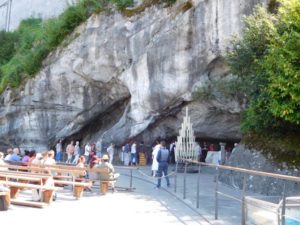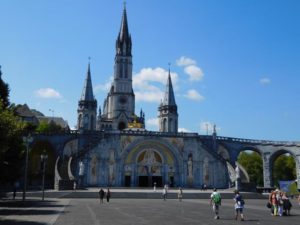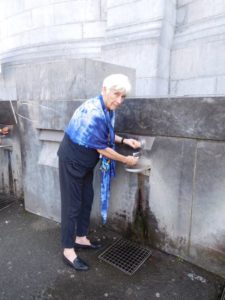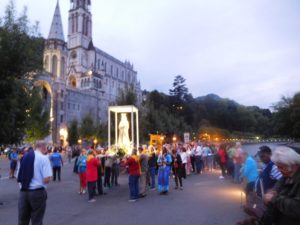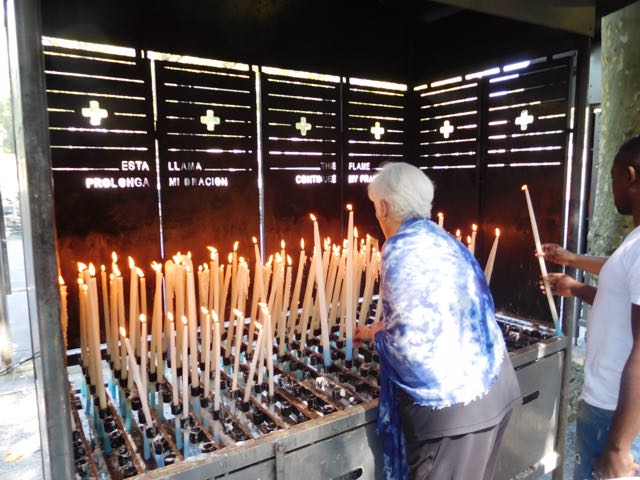Visiting Lourdes, France, on the edge of the Pyrenees, is a step into religious mania and passion. It is, first, a shrine to Bernadette, the young girl who had multiple encounters with the mother of Christ, the Virgin Mary, at the edge of an overhanging rock cavern, which one gets to touch, to draw ones hand along the edge of the entrance, walking in a line of pilgrims hoping to be healed and forgiven for things uncomfortable in their souls. The story of Bernadette is the icon of all the Visitation stories.
As I wanted to bathe in the moment, the tradition, the being present although feeling a little foreign to such unrestrained adorations, I joined in the line of hopefuls and was moved by the cool, marble-like feeling of the cavern stones, polished by the millions of hands and fingers which have gone before, hoping somehow the miracles that were shared between the two young women (Bernadette described the Virgin Mary as being about her small size and age)
would pass on to the penitent and suffering. It was one of the many opportunities to worship the Virgin Mary and, now, St. Bernadette for the 24 hours of walking, talking, praying and learning about this most popular of destinations for so many, Roman Catholic or not. The magnitude of it takes one’s breath away, sort of like St. Jude does in Memphis.
 Though streets wind through the city, mostly shaped by giant hotels that seem to rise up out of rock, one follows a blue line to completely engaged in the tour of St. Bernadette’s life, stopping at her father’s house (where beds were in the kitchen to sleep warm; the flour mill which provided income for the family was in the same structure) and her convent and oddly, plenty of photographs of her and her family and the priests involved with her very devout life, since it took place in the late 19th century when cameras were the next convenience. The Lourdes site, I was told, is part of the route of the Camino de Santiago Compostela and it is far more adored and visited than, for instance, Avila in Spain where the extraordinary work and life of St. Teresa de Avila was a more compact, personal, less obsessed and more studied experience of the amazing saint she was. The Bernadette experience has far more impact on the public with what it offers as an experience in healing and blessings, much as the Virgin of Guadalupe in Mexico City, who now has a niche in the Lourdes shrine with an impressive statue. (The Virgin of Guadalupe in Mexico is the second most visited religious site next to Roma, Italy.) The bulk of the penitential who come to Lourdes are people in pain.
Though streets wind through the city, mostly shaped by giant hotels that seem to rise up out of rock, one follows a blue line to completely engaged in the tour of St. Bernadette’s life, stopping at her father’s house (where beds were in the kitchen to sleep warm; the flour mill which provided income for the family was in the same structure) and her convent and oddly, plenty of photographs of her and her family and the priests involved with her very devout life, since it took place in the late 19th century when cameras were the next convenience. The Lourdes site, I was told, is part of the route of the Camino de Santiago Compostela and it is far more adored and visited than, for instance, Avila in Spain where the extraordinary work and life of St. Teresa de Avila was a more compact, personal, less obsessed and more studied experience of the amazing saint she was. The Bernadette experience has far more impact on the public with what it offers as an experience in healing and blessings, much as the Virgin of Guadalupe in Mexico City, who now has a niche in the Lourdes shrine with an impressive statue. (The Virgin of Guadalupe in Mexico is the second most visited religious site next to Roma, Italy.) The bulk of the penitential who come to Lourdes are people in pain.
Not only is the landscape pristine and abundant in tall corn, grains and other farming produce, but hotels and structures are carved into and out of huge rock mountains with death-defying drops. Because of the narrow streets and, in the shrine zone, the excessive souvenir shops, the best mode of getting around is on foot. Lourdes attracts thousands of the suffering, the ill, the aged still looking for miracles and cures , therefore they are enormous resting hospitals where these can stay, be attended to by volunteers (who dress in white and wear blue caps like nun head coverings, ) whose task is to push the very comfortable blue wheel chairs for the elderly and infirm, as part of their dedication to the Bernadette style. The site is just huge. But first one is destined to walk down the narrow street and pass the multitude of endless souvenir shops loaded with statues of the The Virgin Mary in her white and pale blue robe, and candles, and piles of empty bottles (glass and plastic) to collect their holy water, medallions and images of the kneeling Bernadette before the Virgin Mary, and just junk, made, of course, in the Republic of China. I cannot help but flash back to Jesus’s anger at the consumerism in the temple, the tables of which he overturned while pointing out the evil of such a thing in a holy place. True, these massive, repetitive stores are outside the basilica, but you can’t get to that destination without passing the merchants.
There are a number of Basilicas filled with magnificence – and it takes a sturdy ability to climb stairs and walk distances to access them. The Basilica of the Immaculate Conception is filled with mosaic masterpieces of the mercies of the Holy Mother Mary and another overpowering concrete structure called the Underground Basilica of St. Pius X, (one of the three largest in the world: St. Peter’s in Rome being the largest, and a basilica in Ivory Coast second, and this one third) are architecturally original with a Gothic tone. In the Basilica of Immaculate
Conception there are layers of floors which can be accessed by exterior stairs that require a huff and a puff, but at the mezzanine level, the pilgrim can sit below an enormous gold crown, symbolizing the mother of Christ. Descending is easy down a long curving ramp that ends relatively close to the Chapel of Confession where pews of penitents wait to confess to priests representing a variety of languages. I had a bottle of the healing water blessed by a priest from Holland. That was quick.
Each night at 9 p.m., a holy procession of people from all over the world – Africans, Asians, Indians, European, the lame and the sick come together to hold a candle and follow the procession behind and around the holy statue of the Virgin Mary which normally resides in the giant Gothic Basilica on the upper level. It is a beautiful example of how the world can share in something they believe in, without fear, although there have been many threats since the Paris bombings, and police cordon off areas at certain times of the day and night when the penitents are attending mass – somewhere there is always a mass under way. It all culminates when the statue of the Virgin Mary is carried like a sedan chair on the shoulders of a select few men in red shirts with yellow bandanas, around the grounds of the Basilica, while the multitudes carry lit candles, some cupped with a paper blocker supposedly to keep the wind from blowing them out, and follow the procession as somewhere priests sing, pray to the Virgin Mary, say the Lord’s Prayer and Hail Mary in various languages, and keep the crowd holy for the hour it takes to make the rounds. It has to move your soul to see so many who believe and if you miss that, there is a special area where large metal tables-like booths give you a chance to buy, light and place a candle (fat, thin, tall or short) and it truly is not removed. it just burns on its own terms until the wax is done so that all the heart put into the prayer and lighting of that candle for someone or something is lifted to the Lord.
Further down this path are the baths. The sick and lame line up here in long queues (pushed by those volunteers) and are given a chance to actually bathe in the waters of the Gave River. The other most popular activity – and I indulged in this, was filling all sorts of plastic and glass bottles with supposedly healing (but not holy) water. There are two areas where there is a series of faucets (push the button and water comes out) connected to the Gave. Some have gallon plastic containers to fill (tedious to wait for that), and others small glass bottles (if you buy ten you get a funnel for free). Others splash their faces, arms, hair, bodies with the water, which could be refreshing on a hot day, and gives hope of healing in the process. Lourdes is all about water and the Gave River is clear, always running strong, and in some spots, trout can be fished. The waters in those bottles still need to be blessed to become holy.

